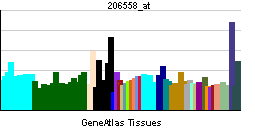Entrez 6493 | Ensembl ENSG00000159263 | |
 | ||
External IDs MGI: 98307 HomoloGene: 3716 GeneCards: SIM2 | ||
Single-minded homolog 2 is a protein that in humans is encoded by the SIM2 gene. It plays a major role in the development of the central nervous system midline as well as the construction of the face and head.
Contents
Function
SIM1 and SIM2 genes are Drosophila single-minded (sim) gene homologs. The Drosophila sim gene encodes a transcription factor that is a master regulator of neurogenesis of midline cells in the central nervous system. SIM2 maps within the so-called Down syndrome chromosomal region, specifically on the q arm of chromosome 21, band 22.2. Based on the mapping position, its potential function as transcriptional repressor and similarity to Drosophila sim, it is proposed that SIM2 may contribute to some specific Down syndrome phenotypes
Interactions
SIM2 has been shown to interact with Aryl hydrocarbon receptor nuclear translocator.
When the SIM2 gene is tranfected into PC12 cells, it effects the normal cycle of cell maturation. SIM2 inhibits the expression of cyclin E, which in turn inhibits the cell's ability to pass through the G1/S checkpoint and suppresses the cell's proliferation ability. it also up-regulates the presence of p27, a growth inhibitor protein. The presence of p27 inhibits the activation of cell cycle regulatory kinases.
Disease state
There are three states of the gene: +/+, +/-, and -/-. When the gene is expressed as SIM2 -/-, it is considered disrupted and many physical malformations are seen, particularly in the craniofacial area. Individuals with SIM2 -/- have either a full or partial secondary palate cleft and malformations in the tongue and pterygoid processes of the sphenoid bone. These malformations cause aerophagia, or the swallowing of air, and postnatal death. Severe aerophagia leads to accumulation of air in the gastrointestinal tract, causing the belly to be distended. It is thought that the over-expression of the SIM2 gene brings about some of the phenotypic deformities that are characteristic of Down syndrome. The presence of SIM2 mRNA in many parts of the brain known to show deformities in individuals with Down syndrome, as well as in the palate, oral and tongue epithelia, mandibular and hyoid bones.
Knockout model
Scientists can purposefully "knockout" or cause the gene to be disrupted. To do this, they perform homologous recombination and eliminate the predicted start codon and the following 47 amino acids. Then the EcoRI restriction site is introduced into the chromosome.
